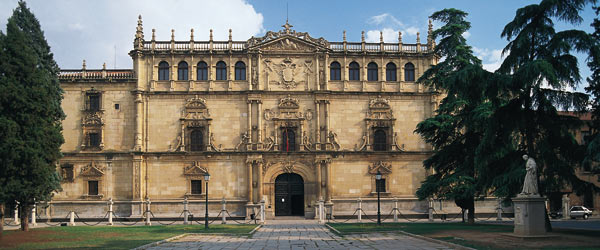Alcalá de Henares, the city of learning
Just 35 kilometres from Madrid there is a town that has made a fundamental contribution to universal culture, and especially in the 16th and 17th centuries: this is Alcalá de Henares. Its university and its historic quarter have both been awarded the World Heritage designation by the UNESCO. It is also the birthplace of the writer Miguel de Cervantes, author of the immortal work Don Quixote.
Culture. This word describes Alcalá de Henares perfectly. It is a city with 2,000 years of history, whose origins go back to the ancient Roman Complutum. The best way to see for yourself is to visit the historic old town and enjoy its stunning monuments and heritage.
This historic centre is home to a number of churches, palaces, mansions, gardens, monasteries, chapels, halls of residence... Take a look at the rooftops and chimneys of these buildings and you will see some very special tenants: white storks that make their nests on the roofs, and which have become a genuine symbol of the town. Of all its buildings, the University is particularly outstanding. It is the real epicentre of life in Alcalá, and was the first complex to be designed and built exclusively as a university campus. This was how this town so close to Madrid (access is on the N-II road) became a cultural centre in the 16th and 17th centuries with a reputation that went far beyond the city limits. Famous intellectuals such as Lope de Vega, Quevedo, San Ignacio de Loyola and Calderón de la Barca, amongst others, had ties to the town. It is no coincidence that Alcalá is an essential point on the route of the Spanish language, a major itinerary that takes in places that have been fundamental in the development of the Spanish tongue. This town is a point of reference for students of our language.
However, it was Miguel de Cervantes, author of Don Quixote, one of the most important works of universal literature, who left the greatest mark on Alcalá de Henares. You will feel his presence in almost every corner of the town. His memory and legacy are alive and well to this day, not only in the house of his birth, now a museum, but also in the town's cultural agenda and in other emblematic spots such as the Cervantes Theatre, the site of Europe's oldest "corral de comedias" (courtyard theatre). Be sure to take a stroll down the main street of Calle Mayor, the central axis of the old town, which is packed with shops, restaurants, bars and buildings with centuries of history. This is the best way to experience the hustle and bustle of a town whose liveliness is partly thanks to the thousands of young people who come to study at the University.
A fun and original way to get to Alcalá is on the Cervantes Train. It runs in spring and autumn and departs from Atocha station in Madrid. On the way, a group of actors in period dress play out pieces taken from works by Miguel de Cervantes. Meanwhile, stewards on the train give out typical sweets from Alcalá de Henares. After visiting the city with a group of professional guides, the train takes its passengers back to Madrid, and there is a raffle for a copy of Don Quixote during the ride.
For more information on this service, check RENFE’s official website.







